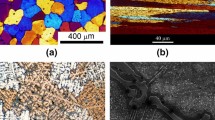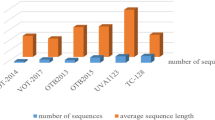Abstract
Mineral segmentation in ceramic thin sections containing different minerals, in which there are no evident and close boundaries, is a rather complex process. The results of such a process are used in archaeology for analyzing the origin and manufacturing techniques of ancient ceramics. In this paper we present a methodology for the segmentation and analysis of thin sections of material segments and reaching some conclusions in a fully automatic way. We employ machine learning and computer vision techniques to analyze a video of the thin section sample, acquired under an optical microscope. When examined under polarized light, the color of segments may vary during sample rotation. This variation is due to the optical properties of the materials and it provides valuable information about the material inclusions in the sample. Using the video as our input, we perform an entire-video segmentation. To accomplish this task, we developed a hierarchical categorical mean-shift-based algorithm. Using the entire-video segmentation we examine the detected segments and gather statistical information about their sizes, shapes and colors and present an overall report about the sample. We tested the algorithm on nine specimens of ancient ceramics, taken from three different Mediterranean sites. The results show clear differences between the sites in the amounts, sizes and shapes of the segments present in the specimens.









































Similar content being viewed by others
References
Albero Santacreu, D.: Materiality, Techniques and Society in the Pottery Production: The Technological Study of Archaeological Ceramics Through Paste Analysis. Walter de Gruyter GmbH & Co KG (2014)
Aligholi, S., Lashkaripour, G.R., Khajavi, R., Razmara, M.: Automatic mineral identification using color tracking. Pattern Recogn. 65, 164–174 (2017)
Arun, K., Huang, T., Blostein, S.: Least-squares fitting of two 3-d point sets. IEEE Trans. Pattern Anal. Mach. Intell. 9(5), 698–700 (1987)
Bay, H., Ess, A., Tuytelaars, T., Gool, L.V.: Speeded-up robust features (SURF). Comput. Vis. Image Underst. 110(3), 346–359 (2008)
Borgers, B., Tol, G., de Haas, T.: Roman cooking vessels (ollae): a preliminary study of the material from the pontine region, central Italy. STAR 3(2), 314–325 (2017)
Chan, T.F., Vese, L.A.: Active contours without edges. Trans. Image Process. 10(2), 266–277 (2001)
Comaniciu, D., Meer, P.: Mean shift: a robust approach toward feature space analysis. IEEE Trans. Pattern Anal. Mach. Intell. 24(5), 603–619 (2002)
Ester, M., Kriegel, H.P., Sander, J., Xu, X.: A density-based algorithm for discovering clusters in large spatial databases with noise. In: KDD, pp. 226–231. AAAI Press (1996)
Getreuer, P.: Chan–Vese segmentation. Image Process. Line 2, 214–224 (2012)
Gibbs, K.T.: Ceramic petrography: the interpretation of archaeological pottery and related artefacts in thin section. Patrick Sean Quinn. 2013. Archaeopress, oxford, 260 pp., color, ISBN 978-1-905-73959-2. Geoarchaeology 29(6), 496–497 (2014)
Hryciw, R., Zheng, J.: Particle roundness and sphericity from images of assemblies by chart estimates and computer methods. J. Geotech. Geoenviron. Eng. 142, 04016038 (2016)
Izadi, H., Sadri, J., Bayati, M.: An intelligent system for mineral identification in thin sections based on a cascade approach. Comput. Geosci. 99(Supplement C), 37–49 (2017)
Izadi, H., Sadri, J., Mehran, N.A.: A new intelligent method for minerals segmentation in thin sections based on a novel incremental color clustering. Comput. Geosci. 81(Supplement C), 38–52 (2015)
Jungmann, M., Pape, H., Wißkirchen, P., Clauser, C., Berlage, T.: Segmentation of thin section images for grain size analysis using region competition and edge-weighted region merging. Comput. Geosci. 72(Supplement C), 33–48 (2014)
Krähenbühl, P., Koltun, V.: Efficient inference in fully connected CRFs with gaussian edge potentials. CoRR arXiv:1210.5644 (2012)
Lerner, J.: Full results (2021). https://drive.google.com/drive/folders/1yLMDebnMPU7k9tIxuP_3lUNqCsVm0Ryb?usp=sharing
Lowe, D.G.: Distinctive image features from scale-invariant keypoints. Int. J. Comput. Vis. 60(2), 91–110 (2004)
Lu, B., Cui, M., Liu, Q., Wang, Y.: Automated grain boundary detection using the level set method. Comput. Geosci. 35(2), 267–275 (2009)
Muja, M., Lowe, D.: Fast approximate nearest neighbors with automatic algorithm configuration. In: VISAPP 2009—Proceedings of the 4th International Conference on Computer Vision Theory and Applications, vol. 1, pp. 331–340 (2009)
Peterson, S.E., Betancourt, P.P.: Thin-section petrography of ceramic materials. In: INSTAP Archaeological Excavation Manual, vol. 2. INSTAP Academic Press, Philadelphia (2009)
Quinn, P., Burton, M.: Ceramic petrography and the reconstruction of hunter-gatherer craft technology in late prehistoric southern California. In: Interpreting Silent Artefacts: Petrographic Approaches to Cultural Materials, pp. 267–295 (2009)
Raith, M., Raase, P., Reinhardt, J.: Guide to Thin Section Microscopy, 2nd edn. Citeseer (2012)
Rand, W.M.: Objective criteria for the evaluation of clustering methods. J. Am. Stat. Assoc. 66(336), 846–850 (1971)
Rodriguez, J., Edeskär, T., Knutsson, S.: Particle shape quantities and measurement techniques: a review. Electron. J. Geotech. Eng. 18/A, 169–198 (2013)
Ronneberger, O., Fischer, P., Brox, T.: U-net: convolutional networks for biomedical image segmentation. In: International Conference on Medical Image Computing and Computer-assisted Intervention, pp. 234–241. Springer (2015)
Ross, B.J., Fueten, F., Yashkir, D.Y.: Automatic mineral identification using genetic programming. Mach. Vis. Appl. 13(2), 61–69 (2001)
Rother, C., Kolmogorov, V., Blake, A.: “grabcut” interactive foreground extraction using iterated graph cuts. ACM Trans. Graph. (TOG) 23(3), 309–314 (2004)
Sørensen, B.E.: A revised Michel-Lévy interference colour chart based on first-principles calculations. Eur. J. Miner. 25(1), 5–10 (2013)
Stoltman, J.B.: The Role of Petrography in the Study of Archaeological Ceramics, pp. 297–326. Springer, Boston (2001)
Stoltman, J.B., Marcus, J., Flannery, K.V., Burton, J.H., Moyle, R.G.: Petrographic evidence shows that pottery exchange between the olmec and their neighbors was two-way. Proc. Natl. Acad. Sci. 102, 11213–8 (2005)
Tite, M.: Pottery production, distribution, and consumption-the contribution of the physical sciences. J. Archaeol. Method Theory 6, 181–233 (1999)
Wikipedia contributors: Achziv—Wikipedia, the free encyclopedia (2020) (online). https://en.wikipedia.org/w/index.php?title=Achziv &oldid=995628079. Accessed 28 Dec 2020
Wikipedia contributors: birefringence—Wikipedia, the free encyclopedia (2020) (online). https://en.wikipedia.org/w/index.php?title=Birefringence &oldid=991256320. Accessed 28 Dec 2020
Wikipedia contributors: Hala Sultan Tekke—Wikipedia, the free encyclopedia (2020) (online). https://en.wikipedia.org/w/index.php?title=Hala_Sultan_Tekke &oldid=994592848. Accessed 28 Dec 2020
Wikipedia contributors: Tel Shikmona—Wikipedia, the free encyclopedia (2020) (online). https://en.wikipedia.org/w/index.php?title=Tel_Shikmona &oldid=992720153. Accessed 28 Dec 2020
Author information
Authors and Affiliations
Corresponding author
Additional information
Publisher's Note
Springer Nature remains neutral with regard to jurisdictional claims in published maps and institutional affiliations.
This research was partially funded by the Israeli Ministry Science and Technology (MOST) grant number 3-17513.
Appendix: Detailed results
Appendix: Detailed results
Figures 33, 34, 35, 36, 37, 38, 39, 40 and 41 summarize the result of each site individually. The final results of each sample video include:
-
1.
An area histogram, which shows the distribution of the area of the segments.
-
2.
A length histogram, which shows the distribution of the segment’s length.
-
3.
A compactness vs. eccentricity heatmap, which shows the general segment shape distribution.
-
4.
Compactness vs. eccentricity examples, which show one example segment for each bin.
-
5.
The final segmented result of the entire video, which shows all the identified segments, in the video.
-
6.
One example frame from the video.
-
7.
A color histogram that shows the segment color distribution.
Rights and permissions
About this article
Cite this article
Lerner, J., Shimshoni, I. Thin section analysis for ceramic petrography using motion analysis and segmentation techniques. Machine Vision and Applications 33, 70 (2022). https://doi.org/10.1007/s00138-022-01324-8
Received:
Revised:
Accepted:
Published:
DOI: https://doi.org/10.1007/s00138-022-01324-8




